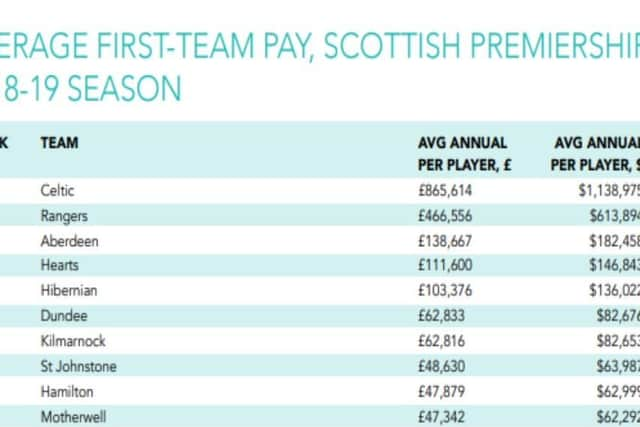Revealed: Extent of Celtic's financial dominance over Scottish football rivals


Put together by Sporting Intelligence, the 2018 edition has shone a light on the Parkhead club's considerable resource in comparison to their Ladbrokes Premiership rivals.
The GSSS' key metric is ‘average first-team pay’, and for the 2018-2019 season it reports that the average salary paid to a Celtic player is £865,614, nearly £400,000 more than rivals Rangers (£466,556). In third place Aberdeen trail even further behind with an average salary per player of £138,667.
Advertisement
Hide AdAdvertisement
Hide Ad

At the other end of the scale, Livingston pay £34,882, around £11,000 less per player than St Mirren who are 11th on the list.
A total of £54,633,280 are paid in salaries by the 12 top tier clubs, an average salary per player of £176,236.
The ratio between Celtic and Livingston is nearly 25:1. Of the 18 sports leagues from around the world the report analysed, only France's Ligue 1 has a less 'fair' spread between top and bottom.
The chasm is highlighted when Celtic are compared to the English Premier League champions Manchester City.


The report said: "The difference between the average basic Celtic salary at the top of the Scottish Premiership pay list (£865,614) and the average Livingston basic at the bottom (£35,000) is even larger than last season. To put this into context, there is considerably less of a resource gulf between Celtic and reigning Premier League champions Manchester City than between Celtic and most clubs in their own division.
"Using our GSSS numbers from this report, City players earn ‘only’ seven times as much as those at Celtic, who in turn earn around 20 times the basic paid at Motherwell, Hamilton and St Johnstone."
In recent weeks respected football finance blogger Swiss Ramble has analysed the accounts of both Rangers and Hearts. In doing so it revealed that Celtic's revenue was an incredible £101.6million, more than three times as much as Rangers and over ten times as much as Hibs.
The GSSS report said: "If the money alone talked, then the title would be Celtic’s with Rangers as runners-up ahead of Aberdeen, Hearts and Hibernian. Livingston, St Mirren and Motherwell would be scrapping it out to avoid the drop. But as has already been demonstrated in Scotland in 2018-19 so far, financial advantage can be wasted while good managers can turn lesser resources into a greater sum than their parts."
GSSS explained
Advertisement
Hide AdAdvertisement
Hide AdSporting Intelligence’s global sports salaries survey came to life in 2009 "to compare, on a like-for-like basis as closely as possible, how much ‘average’ sportsmen earned at hundreds of different clubs and teams around the world in hugely contrasting professional sports".
The GSSS has always analysed ‘average first-team pay’.
"By ‘average’, we mean ‘arithmetic mean’. All the salaries are added up (and by salaries, we include basic guaranteed pay for playing sport for that team, not for bonuses or endorsements or sponsorship or anything else extra-curricular) and divided by the number of players. That’s it. A simple list that provokes complicated arguments but does at the very least, provide a ‘ball park’ reckoner of what different sports teams pay."
As the name suggests the data is collected via survey.
More accurately they are the result of an analysis and organisation of data either A) established as fact in those leagues where minutiae are in the public domain; or B) gathered by survey methods from a multitude of knowledgeable sources, more of which in a moment.
All figures (across all leagues) are sourced directly or indirectly from one or more of unions, player associations, players themselves, agents, leagues, clubs and / or club sources, and other reliable administrative bodies.
Why average pay?
We believe average pay is important - as opposed to total wage outlay - because two teams spending the same totals on salaries will have starkly different averages if they are paying a significantly different number of players. It happens, and it matters. You can employ a higher number of lower quality players for the same price as a smaller number of higher quality players, and we think it’s worth exploring which is most effective for performance.
